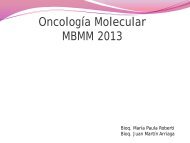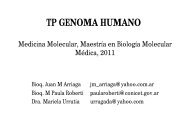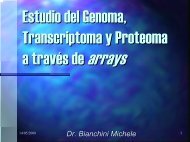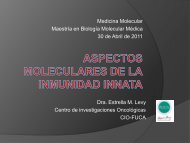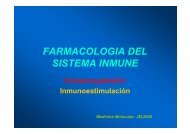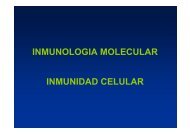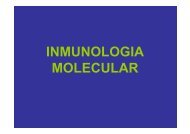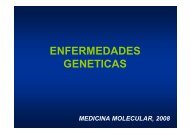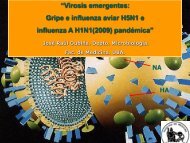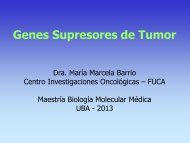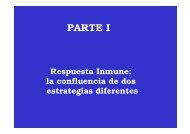Algunos aportes de la BiologÃa Molecular a la VirologÃa - José Mordoh
Algunos aportes de la BiologÃa Molecular a la VirologÃa - José Mordoh
Algunos aportes de la BiologÃa Molecular a la VirologÃa - José Mordoh
Create successful ePaper yourself
Turn your PDF publications into a flip-book with our unique Google optimized e-Paper software.
<strong>Algunos</strong> <strong>aportes</strong><br />
<strong>de</strong> <strong>la</strong> Biología Molecu<strong>la</strong>r<br />
a <strong>la</strong> Virología<br />
Prof. Dr. José Raúl Oubiña<br />
Facultad <strong>de</strong> Medicina, UBA
Biología<br />
molecu<strong>la</strong>r<br />
Elementos<br />
<strong>de</strong><br />
Infectología<br />
Virología<br />
Epi<strong>de</strong>miología<br />
Inmunología
Biología<br />
Biología<br />
molecu<strong>la</strong>r<br />
Bioquímica<br />
Genética
La Virología y <strong>la</strong> Biología molecu<strong>la</strong>r<br />
Virología<br />
Profi<strong>la</strong>xis Patogenia<br />
Diagnóstico<br />
Epi<strong>de</strong>miología<br />
Descubrimiento <strong>de</strong><br />
virus<br />
Diagnóstico virológico<br />
Monitoreo <strong>de</strong><br />
terapéutica<br />
Patogénesis viral<br />
Epi<strong>de</strong>miología<br />
molecu<strong>la</strong>r<br />
Producción <strong>de</strong> vacunas<br />
por ingeniería genética<br />
Desarrollo <strong>de</strong><br />
terapéuticas<br />
específicas (siRNAs)
James D. Watson y Francis Crick<br />
Marzo <strong>de</strong> 1953
I. Descubrimiento <strong>de</strong> virus<br />
• Historia: <strong>la</strong> transmisión <strong>de</strong> <strong>la</strong>s propieda<strong>de</strong>s<br />
<strong>de</strong> un virus es posible merced a sus ácidos<br />
nucleicos: experimentos con bacteriófagos.<br />
• Secuenciamiento nucleotídico <strong>de</strong>l<br />
bacteriófago Phi X 174.
Descubrimiento <strong>de</strong> virus mediante<br />
Biología molecu<strong>la</strong>r<br />
Virus Hepatitis C<br />
Virus Hepatitis E<br />
Herpes virus humano tipo 8<br />
West Nile (Virus <strong>de</strong>l Nilo Occi<strong>de</strong>ntal)<br />
GBV-C<br />
Coronavirus asociado al SARS<br />
Virus Borna<br />
Bocavirus<br />
Polyomavirus (Wu, RI)<br />
Arenavirus LCM (Linfocoriomeningitis linfocitaria) – símil<br />
(¿o una variante <strong>de</strong>l mismo LCM?
Fre<strong>de</strong>rick Sanger<br />
• 1977.<br />
Habiendo obtenido el Premio<br />
Nobel por <strong>de</strong>scubrir <strong>la</strong><br />
secuencia aa. <strong>de</strong> <strong>la</strong> insulina,<br />
<strong>de</strong>termina <strong>la</strong> secuencia<br />
nucleotídica completa <strong>de</strong>l<br />
bacteriófago Phi X 174.<br />
Este fue el primer genoma<br />
completo secuenciado <strong>de</strong><br />
algún organismo<br />
<strong>de</strong>terminado.<br />
ES HONRADO CON UN<br />
SEGUNDO PREMIO NOBEL
Secuenciamiento nucleotídico <strong>de</strong> Sanger mediante ddNTPs
Métodos <strong>de</strong> marcación <strong>de</strong>l DNA polimerizado<br />
5`<br />
3`<br />
Cebador<br />
DNA Temp<strong>la</strong>do<br />
DNA Temp<strong>la</strong>do<br />
ddNTP<br />
Cebador<br />
Cebador
Un hito en <strong>la</strong> historia <strong>de</strong> <strong>la</strong><br />
Microbiología<br />
• 1989<br />
• Se <strong>de</strong>scubre el<br />
primer virus al<br />
margen <strong>de</strong> su<br />
morfología y<br />
estructura<br />
antigénica:<br />
el virus Hepatitis C<br />
M. Houghton<br />
G. Kuo<br />
Q-L Choo<br />
D. Bradley
¿Cómo se <strong>de</strong>scubrió el HCV?<br />
Factor VIII contaminado<br />
con agente <strong>de</strong> Hepatitis<br />
NoA NoB<br />
DNAc<br />
(<strong>de</strong> RNA y DNA)<br />
Clonado en<br />
vector λ gt11<br />
850.000 clones analizados con… Acs <strong>de</strong><br />
un paciente con Hepatitis NoA NoB
Re<strong>la</strong>ción <strong>de</strong>l<br />
HCV<br />
con hepatitis T<br />
leves (HL),<br />
G<br />
crónicas activas<br />
(CA),<br />
CA con cirrosis<br />
(CAC)<br />
y cirrosis<br />
inactivas (CI)<br />
HL CA CAC CI<br />
RIBA PARA HEPATITIS C
Prueba <strong>de</strong> ELISA (Enzyme linked-immunosorbent assay)<br />
Para <strong>de</strong>tectar anticuerpos
Mauritz Kohn<br />
(Kaposi)<br />
Sarcoma <strong>de</strong> Kaposi
Descubrimiento <strong>de</strong>l DNA <strong>de</strong> HHV-8<br />
I<strong>de</strong>ntification of herpesvirus-like DNA sequences in<br />
AIDS-associated Kaposi's sarcoma.<br />
Chang Y, Cesarman E, Pessin MS, Lee F, Culpepper J, Knowles DM, Moore<br />
PS.<br />
• Analysis was used to iso<strong>la</strong>te unique sequences present in more<br />
than 90 percent of Kaposi's sarcoma (KS) tissues obtained from<br />
patients with acquired immuno<strong>de</strong>ficiency syndrome (AIDS).<br />
These sequences were not present in tissue DNA from non-<br />
AIDS patients, but were present in 15 percent of non-KS tissue<br />
DNA samples from AIDS patients. The sequences are<br />
homologous to, but distinct from, capsid and tegument protein<br />
genes of the Gammaherpesvirinae, herpesvirus saimiri and<br />
Epstein-Barr virus. These KS-associated herpesvirus-like<br />
(KSHV) sequences appear to <strong>de</strong>fine a new human herpesvirus.<br />
Science 266:1865-9. 1994
DNA <strong>de</strong> Tejido normal<br />
DNA <strong>de</strong> Tejido tumoral con DNA <strong>de</strong><br />
HHV-8<br />
Clivaje con endonucleasas<br />
Ligado con oligonucleótidos adaptadores<br />
Desnaturalización<br />
Hibridación sustractiva <strong>de</strong>l DNA <strong>de</strong>l tejido tumoral con el <strong>de</strong>l tejido normal
Relleno <strong>de</strong>l DNA parcialmente bicatenario y Amplificación por PCR con<br />
cebadores complementarios a los adaptadores<br />
DNA reasociado <strong>de</strong>l tejido normal +<br />
Híbridos <strong>de</strong> DNA <strong>de</strong>l tejido normal y <strong>de</strong>l tumoral +<br />
Temp<strong>la</strong>do tipo 1. PCR sin<br />
amplificación<br />
(el DNA no tiene adaptadores)<br />
Temp<strong>la</strong>do tipo 2. PCR sin amplificación<br />
(sólo una ca<strong>de</strong>na <strong>de</strong> DNA tiene<br />
adaptadores)<br />
Temp<strong>la</strong>do tipo 3. DNA <strong>de</strong><br />
HHV- 8 amplificado por PCR
Análisis <strong>de</strong> diferencias<br />
representativas (ARD) <strong>de</strong> DNA<br />
• Hibridación sustractiva<br />
(entre DNA <strong>de</strong> tejido tumoral vs no tumoral)<br />
+<br />
• Adaptadores oligonucleótidos conocidos<br />
ligados a los extremos <strong>de</strong> DNA no hibridado<br />
• PCR con cebadores complementarios a los<br />
adaptadores, secuenciamiento nucleotídico y<br />
análisis filogenético
Figure 1. Example of KS330 233<br />
PCR Amplifications from the First Batch of Tissue Samples from Patients with<br />
Kaposi's Sarcoma and Controls.<br />
Amplification products are <strong>de</strong>tectable in DNA samples from an HIV-seronegative homosexual man with Kaposi's<br />
sarcoma (<strong>la</strong>ne 1, Patient 18), a patient with c<strong>la</strong>ssic Kaposi's sarcoma (<strong>la</strong>ne 6, Patient 12), and a patient with<br />
AIDS-associated Kaposi's sarcoma (<strong>la</strong>ne 9, Patient 4). One sample from a patient with AIDS-associated Kaposi's<br />
sarcoma (<strong>la</strong>ne 4, Patient 3) failed to generate a PCR product <strong>de</strong>tectable by Southern hybridization in repeated<br />
blind evaluations. The PCR product was amplifiable in all the remaining 17 samples from the patients with<br />
Kaposi's sarcoma (not shown). Samples in <strong>la</strong>nes 2, 5, and 8 (DNA from uninvolved tissue from patients with<br />
Kaposi's sarcoma) and <strong>la</strong>nes 3 and 7 (control DNA samples from patients without Kaposi's sarcoma) are negative.<br />
Lane 10 contains a negative control (no DNA), <strong>la</strong>ne 11 contains a positive control (DNA from a patient with AIDSassociated<br />
Kaposi's sarcoma) previously shown to contain Kaposi's sarcoma–associated herpesvirus<br />
sequences, 16 and <strong>la</strong>ne m is a molecu<strong>la</strong>r-weight marker.
Cloning of a human parvovirus by molecu<strong>la</strong>r<br />
screening of respiratory tract samples<br />
PNAS September 6, 2005 vol. 102 no. 36 12891–12896<br />
• Tobias Al<strong>la</strong>n<strong>de</strong>r*†‡, Martti T. Tammi§, Margareta Eriksson, Annelie Bjerkner*, Annika Tiveljung-Lin<strong>de</strong>ll*, and Bjo¨<br />
rn An<strong>de</strong>rsson§ Karolinska University Laboratory, Stockholm, Swe<strong>de</strong>n,<br />
• The i<strong>de</strong>ntification of new virus species is a key issue for the study of<br />
infectious disease but is technically very difficult. We <strong>de</strong>veloped a system for<br />
<strong>la</strong>rge-scale molecu<strong>la</strong>r virus screening of clinical samples based on host DNA<br />
<strong>de</strong>pletion, random PCR amplification, <strong>la</strong>rge-scale sequencing, and<br />
bioinformatics. The technology was applied to pooled human respiratory<br />
tract samples. The first experiments <strong>de</strong>tected seven human virus species<br />
without the use of any specific reagent. Among the <strong>de</strong>tected viruses were<br />
one coronavirus and one parvovirus, both of which were at that time<br />
uncharacterized. The parvovirus, provisionally named human bocavirus, was<br />
in a retrospective clinical study <strong>de</strong>tected in 17 additional patients and<br />
associated with lower respiratory tract infections in children. The molecu<strong>la</strong>r<br />
virus screening procedure provi<strong>de</strong>s a general culture-in<strong>de</strong>pen<strong>de</strong>nt solution<br />
to the problem of <strong>de</strong>tecting unknown virus species in single or pooled<br />
samples. We suggest that a systematic exploration of the viruses that infect<br />
humans, ‘‘the human virome,’’ can be initiated.
Descubrimiento <strong>de</strong>l Bocavirus humano
Otras estrategias, nuevos virus...<br />
• SISPA-PCR<br />
• Random-PCR<br />
• DNAsa-SISPA PCR<br />
Tamizaje <strong>de</strong>l<br />
“Viroma” humano:<br />
Bocavirus,<br />
Polyomavirus Wu y<br />
KI.<br />
• Pirosecuenciación:<br />
LCM-símil (2008)
Pirosecuenciación <strong>de</strong> DNA
Diagnóstico
Detección <strong>de</strong> Ácidos nucleicos<br />
Técnica<br />
1. In situ o previa extracción Ej. Hibridación o PCR in situ o previa extracción<br />
2. Sin o con amplificación<br />
2.1. Sin amplificación Hibridación molecu<strong>la</strong>r:<br />
Dot blot<br />
Slot blot<br />
Southern blot<br />
Northern blot<br />
Captura <strong>de</strong> híbridos (con Mab)<br />
2.2. Con amplificación De <strong>la</strong> secuencia b<strong>la</strong>nco<br />
PCR / RT-PCR y variantes (anidada o Nested; SISPA<br />
PCR, etc. )<br />
PCR o RT-PCR competitiva<br />
PCR en tiempo real<br />
TMA (Transcription mediated amplification:<br />
amplificación isotérmica)<br />
3. Cuali o cuantitativa<br />
3.1. Estudio cualitativo<br />
3.2. Estudio cuantitativo<br />
De <strong>la</strong> señal <strong>de</strong> <strong>de</strong>tección:<br />
branched-DNA (DNA ramificado)<br />
pg <strong>de</strong> DNA o RNA / ml<br />
ó<br />
Copias genómicas o UI / ml (carga viral)
Slot blot para cuantificar DNA <strong>de</strong> HBV
5’<br />
3’ RNA viral<br />
3’<br />
RT 5’ Cebador 1<br />
+<br />
Promotor T7 RNA pol<br />
5’<br />
3’<br />
RNAsa H<br />
3’<br />
5’ DNAc<br />
+<br />
3’ 5’<br />
5’ 3’<br />
RT<br />
3’ 5’<br />
5’ ’ 3’<br />
3’ 5’<br />
5’ 3’<br />
Cebador 2<br />
RT<br />
RNAsa H<br />
DNA<br />
5’ 3’<br />
dc<br />
3’<br />
5’<br />
3’ 5’<br />
RT +<br />
3’<br />
Cebador 1<br />
5’<br />
T7 RNA pol<br />
5’ ’ 3’<br />
3’<br />
5’<br />
3’<br />
5’<br />
3’<br />
5’<br />
3’ 5’ 10 2 -10 3 copias <strong>de</strong> RNA
Kary Mullis<br />
Inventor <strong>de</strong> <strong>la</strong> PCR<br />
Premio Nobel <strong>de</strong> Química<br />
<strong>de</strong> 1996
5’<br />
3’<br />
DNA<br />
+ cebadores<br />
5’<br />
C<br />
+ dNTPs<br />
3’<br />
5’<br />
3’<br />
+ DNA pol<br />
termoestable<br />
I<br />
C<br />
L<br />
O<br />
1<br />
C<br />
I<br />
C<br />
2<br />
O<br />
5’<br />
L<br />
3’<br />
3’<br />
3’<br />
5’<br />
3’ 5’<br />
5’<br />
3’ 5’<br />
5’ 3’<br />
5’<br />
5’<br />
3’ 5’<br />
3’<br />
5’<br />
3’<br />
5’<br />
3’<br />
5’<br />
3’ 5’ 5’<br />
5’ 3’<br />
5’<br />
3’<br />
5’<br />
3’ 5’ 5’<br />
3’<br />
5’<br />
3’<br />
5’<br />
3’<br />
5’<br />
5’<br />
5’<br />
3’<br />
3’<br />
5’<br />
5’<br />
3’<br />
5’<br />
3’<br />
5’<br />
3’<br />
3’<br />
5’
1ra.<br />
amplificación<br />
3´<br />
5´<br />
5´<br />
5´<br />
5´<br />
3´<br />
DNA<br />
Productos <strong>de</strong> <strong>la</strong><br />
1ra. PCR<br />
5´<br />
3´<br />
3´<br />
5´<br />
DNA<br />
2da.<br />
amplificación<br />
5´<br />
3´<br />
5´<br />
5´<br />
3´ 5´<br />
DNA<br />
Productos <strong>de</strong><br />
<strong>la</strong> 2da. PCR<br />
5´<br />
3´<br />
3´<br />
5´<br />
DNA
PCR para <strong>de</strong>tección <strong>de</strong> los genes<br />
env y gag <strong>de</strong> HIV en linfo-mononucleares<br />
gag<br />
env<br />
Beta actina
Southern blot <strong>de</strong> una RT- PCR para <strong>de</strong>tectar<br />
RNA<br />
<strong>de</strong> GBV-C en médu<strong>la</strong> ósea <strong>de</strong> pacientes con<br />
enfermeda<strong>de</strong>s onco-hematológicas<br />
1 2 3 4 5 6 7 8 (+) (-)
RT-PCR competitiva<br />
para cuantificar<br />
<strong>la</strong> carga viral <strong>de</strong>l virus GB tipo C<br />
A<br />
M 1 2 3 4 5 6<br />
300 pb<br />
329 pb (B)<br />
262 pb (C)<br />
B<br />
1,0<br />
r = 0,963<br />
0,5<br />
log C/B<br />
0,0<br />
5,0 5,5 6,0 6,5 7,0 7,5 8,0<br />
-0,5<br />
-1,0<br />
log C (molécu<strong>la</strong>s)
PCR a tiempo real<br />
• ¿Por qué es útil?<br />
• ¿Qué es?<br />
• ¿Cómo funciona?<br />
• ¿Para qué sirve?<br />
• ¿A qué virus pue<strong>de</strong> / podría aplicarse?
¿Por qué es útil?<br />
• Amplificación y <strong>de</strong>tección simultáneas.<br />
• Mediante fluorescencia se pue<strong>de</strong> cuantificar<br />
el ADN durante <strong>la</strong> amplificación (cinética).
¿Qué es? (I)<br />
• Es una reacción <strong>de</strong> amplificación mediante<br />
PCR acop<strong>la</strong>da a un lector <strong>de</strong><br />
fluorescencia.<br />
• Utiliza uno <strong>de</strong> los dos sistemas siguientes:<br />
1. Agentes interca<strong>la</strong>ntes.<br />
2. Sondas <strong>de</strong> hibridación específicas.
PCR en tiempo real
Detección mediante agentes<br />
interca<strong>la</strong>ntes (II)<br />
• SYBR green I<br />
• El incremento <strong>de</strong> ADN se traduce en un aumento<br />
<strong>de</strong> <strong>la</strong> fluorescencia<br />
• Muy fácil y muy económico.<br />
• Baja especificidad (<strong>de</strong>tecta multímeros <strong>de</strong><br />
cebadores).<br />
• No <strong>de</strong>tecta polimorfismos.<br />
• Utiliza hot start para aumentar <strong>la</strong> especificidad.<br />
• Mediante análisis <strong>de</strong>l Tm <strong>de</strong> los productos se<br />
pue<strong>de</strong> verificar <strong>la</strong> especificidad (no es absoluto).
Cuantificación genómica<br />
• Utilización <strong>de</strong> un patrón<br />
externo <strong>de</strong><br />
concentraciones conocidas<br />
y crecientes.<br />
• E<strong>la</strong>boración <strong>de</strong> una curva<br />
patrón .<br />
• Determinación <strong>de</strong>l Cp<br />
(crossing point: ciclo en el<br />
que se <strong>de</strong>tecta aumento <strong>de</strong><br />
<strong>la</strong> fluorescencia).
Detección <strong>de</strong> mutaciones<br />
• Mayor estabilidad <strong>de</strong>l<br />
híbrido formado entre<br />
<strong>la</strong> sonda y el ADN<br />
salvaje<br />
vs híbrido<br />
sonda y ADN mutado
Aplicaciones actuales y<br />
perspectivas<br />
• HBV<br />
• HCV<br />
• HIV<br />
• CMV<br />
Otros: Erithrovirus B19, polyomavirus BK y<br />
JC, A<strong>de</strong>novirus, etc.
Sondas <strong>de</strong> hibridación<br />
específica (III)<br />
• Sondas marcadas con dos tipos <strong>de</strong><br />
fluorocromos : donante y aceptor.<br />
• Fundamento FRET: transferencia <strong>de</strong><br />
energía fluorescente mediante resonancia.<br />
• 3 tipos:<br />
Sondas <strong>de</strong> hidrólisis<br />
Sondas Faros molecu<strong>la</strong>res<br />
Sondas FRET
Sondas <strong>de</strong> hidrólisis o TaqMan<br />
DNA<br />
diana<br />
Taq DNA pol<br />
5´→3´exonucleasa<br />
Fluorescencia<br />
<strong>de</strong>l fluorocromo<br />
donante captada<br />
por un lector<br />
sonda<br />
• Oligonucleótidos<br />
marcados en el 5´<br />
(donante) y el 3´<br />
(receptor) que son<br />
hidrolizadas por <strong>la</strong> Taq<br />
DNA pol con actividad 5´-<br />
3´ exonucleasa.<br />
• Captura <strong>de</strong> <strong>la</strong><br />
fluorescencia por un<br />
lector.
Sondas Faros molecu<strong>la</strong>res<br />
Fluorocromo<br />
dador<br />
DNA<br />
diana<br />
Fluorescencia<br />
<strong>de</strong>l dador es<br />
captada por<br />
un lector<br />
Sonda tipo ”faro<br />
molecu<strong>la</strong>r”<br />
Fluorocromo<br />
receptor<br />
• Parecidas a <strong>la</strong>s TaqMan. con<br />
extremos 5´ y 3´ marcados.<br />
• Estructura secundaria en<br />
forma <strong>de</strong> asa don<strong>de</strong> está <strong>la</strong><br />
zona <strong>de</strong> hibridación a<br />
secuencia diana.<br />
• Al hibridarse el asa al ADN,<br />
el donador y el aceptor<br />
quedan distantes, y <strong>la</strong><br />
fluorescencia <strong>de</strong>l primero es<br />
captada por el lector.
Sondas FRET<br />
Fluorescencia<br />
<strong>de</strong>l fluorocromo<br />
dador<br />
Transferencia<br />
<strong>de</strong> <strong>la</strong><br />
fluorescencia<br />
Fluorocromo aceptor<br />
Emisión<br />
fluorescente<br />
<strong>de</strong> diferente<br />
longitud <strong>de</strong><br />
onda<br />
• 2 sondas que se unen a<br />
secuencias adyacentes <strong>de</strong>l<br />
ADN diana.<br />
• Una sonda marcada con el<br />
donador en el 5´y <strong>la</strong> otra<br />
con el aceptor en el 3´.<br />
• Al estar próximas, <strong>la</strong><br />
emisión <strong>de</strong>l donador no es<br />
captada por el lector, sino<br />
por el aceptor, que a su vez<br />
emite fluoresecncia en otra<br />
longitud <strong>de</strong> onda.
Opciones <strong>de</strong> los equipos <strong>de</strong> PCR<br />
a tiempo real<br />
1. Amplificación y <strong>de</strong>tección <strong>de</strong> ADN o<br />
ARN.<br />
2. PCR múltiple<br />
3. Cuantificación <strong>de</strong>l ADN o ARN.<br />
4. Análisis <strong>de</strong> curvas <strong>de</strong> disociación.
Ventajas <strong>de</strong> <strong>la</strong> PCR a tiempo real<br />
1. Menor tiempo requerido.<br />
2. Utilización <strong>de</strong> un sistema cerrado, con<br />
menor chance <strong>de</strong> contaminación.<br />
3. Cuantificación con mayor precisión,<br />
y mayor rango (10 5 -10 5 copias).<br />
4. Simultaneidad <strong>de</strong> ensayos cualicuantitativos,<br />
múltiples y <strong>de</strong> <strong>de</strong>tección <strong>de</strong><br />
mutaciones.
gp160<br />
gp120<br />
CONFIRMACIÓN<br />
WESTERN BLOT<br />
p68<br />
p55<br />
p53<br />
gp41-45<br />
p40<br />
p34<br />
p24<br />
p18<br />
p12<br />
temprana Reciente /<br />
establecida<br />
ANTICUERPOS<br />
avanzada<br />
2 A 6 SEMANAS
Carga viral<br />
CAIDA DE LA CARGA VIRAL DURANTE EL<br />
TRATAMIENTIO<br />
Objetivo <strong>de</strong>l tratamiento<br />
antiviral<br />
Límite <strong>de</strong> <strong>de</strong>tección<br />
Tiempo (meses)<br />
Fuente IAS
CV en p<strong>la</strong>sma como marcador predictivo <strong>de</strong>l<br />
<strong>de</strong>scenso <strong>de</strong> CD4<br />
CD4<br />
BAJA<br />
MEDIANA<br />
ALTA<br />
Años
CARGA VIRAL COMO MARCADOR<br />
Reconocimiento <strong>de</strong>l curso <strong>de</strong> <strong>la</strong> infección<br />
Valor Valor pronóstico<br />
:<br />
* ENFERMEDAD PROGRESIVA<br />
VERSUS ESTABLE<br />
Monitoreo <strong>de</strong> <strong>la</strong> terapia antiviral :<br />
* INICIACIÓN,<br />
N,<br />
MANTENIMIENTO, FALLO
Patogénesis
Análisis <strong>de</strong> <strong>la</strong> expresión diferencial <strong>de</strong> genes celu<strong>la</strong>res<br />
luego <strong>de</strong> <strong>la</strong> infección por A<strong>de</strong>novirus 7h mediante bioarrays<br />
Detalle <strong>de</strong> una imagen obtenida para análisis <strong>de</strong> bioarrays. En los estudios <strong>de</strong> microarrays<br />
se combinan <strong>la</strong>s técnicas <strong>de</strong> hibridación <strong>de</strong> ácidos nucleicos y <strong>de</strong>tección por fluorescencia.<br />
De esta manera, sólo en los puntos <strong>de</strong>l portaobjeto don<strong>de</strong> haya ocurrido hibridación se<br />
<strong>de</strong>tectará <strong>la</strong> fluorescencia, siendo <strong>la</strong> intensidad <strong>de</strong> <strong>la</strong> misma proporcional al nivel <strong>de</strong><br />
expresión <strong>de</strong>l gen en estudio.<br />
Barrero P, 2008. En prensa.
Microdisposiciones <strong>de</strong> DNA<br />
(Microarrays)<br />
• Genes diferencialmente expresados para <strong>la</strong> serie <strong>de</strong> tiempo 1, 2, 8 y 24 horas post-infección <strong>de</strong> A<strong>de</strong>novirus 7h<br />
analizado in vitro en célu<strong>la</strong>s Hep-2. El gráfico presenta un heatmap con <strong>de</strong>ndogramas, calcu<strong>la</strong>do por ANOVA<br />
(análisis <strong>de</strong> varianza). Se muestran los 100 primeros genes que surgen <strong>de</strong>l análisis sobre los bioarrays Co<strong>de</strong>Link<br />
TM<br />
UniSet Human 20K I (GE Healthcare).<br />
• El 50% <strong>de</strong> los genes celu<strong>la</strong>res afectados por <strong>la</strong> infección <strong>de</strong> Av7h está re<strong>la</strong>cionado con <strong>la</strong> entrada <strong>de</strong> <strong>la</strong> célu<strong>la</strong> en<br />
fase S <strong>de</strong>l ciclo celu<strong>la</strong>r, dando así un entorno i<strong>de</strong>al para <strong>la</strong> replicación viral y genes re<strong>la</strong>cionados con mecanismos<br />
<strong>de</strong> <strong>de</strong>fensa antiviral, en particu<strong>la</strong>r <strong>de</strong> <strong>la</strong> vía <strong>de</strong>l interferon. Este trabajo contribuye con <strong>la</strong> exploración <strong>de</strong> los<br />
mecanismos implicados en <strong>la</strong> patogénesis <strong>de</strong>l A<strong>de</strong>novirus 7h.<br />
• Barrero P. 2008. En prensa.
Mutante <strong>de</strong> escape a los anticuerpos neutralizantes anti –HBs (superficie <strong>de</strong> HBV)<br />
Asp<br />
A<strong>la</strong>
Cuasiespecies<br />
• “Distribuciones complejas <strong>de</strong><br />
variantes distintas pero<br />
íntimamente re<strong>la</strong>cionadas.”<br />
• “No existe un genoma <strong>de</strong>finido <strong>de</strong><br />
modo preciso, ya que el genoma<br />
consenso es un promedio <strong>de</strong><br />
variantes.”<br />
• “Su dinámica tiene un<br />
consi<strong>de</strong>rable número <strong>de</strong><br />
implicancias para enten<strong>de</strong>r <strong>la</strong><br />
adaptabilidad <strong>de</strong> un virus, su po<strong>de</strong>r<br />
patogénico y <strong>de</strong> persistencia.”<br />
E. Domingo
Quasispecies diversity <strong>de</strong>termines pathogenesis<br />
through<br />
cooperative interactions within a viral popu<strong>la</strong>tion<br />
Marco Vignuzzi1, Jeffrey K Stone1, Jamie J. Arnold2, Craig E. Cameron2, and Raul Andino1<br />
• Abstract<br />
• Mathematical mo<strong>de</strong>lling predicts that the viral quasispecies is not simply a collection of<br />
diverse mutants but a group of interactive variants, which together contribute to the<br />
characteristics of the popu<strong>la</strong>tion 4,12. In this view, viral popu<strong>la</strong>tions, rather than individuals,<br />
are the target of evolutionary selection 4,12. To test this hypothesis we examined whether<br />
limiting genomic diversity affects viral pathogenesis. We find that poliovirus carrying a high<br />
fi<strong>de</strong>lity polymerase replicates at wildtype levels but generates less genomic diversity and is<br />
unable to adapt to adverse growth conditions.<br />
• In infected animals, the reduced viral diversity led to loss of<br />
neurotropism and an attenuated pathogenic phenotype.<br />
Strikingly, expanding quasispecies diversity of the high fi<strong>de</strong>lity<br />
virus by chemical mutagenesis prior to infection restored<br />
neurotropism and pathogenesis. Analysis of viruses iso<strong>la</strong>ted<br />
from brain provi<strong>de</strong>s direct evi<strong>de</strong>nce for complementation<br />
between members within the quasispecies, indicating that<br />
selection in<strong>de</strong>ed occurred at the popu<strong>la</strong>tion level rather than<br />
on individual mutants. Our study provi<strong>de</strong>s direct evi<strong>de</strong>nce for<br />
a fundamental prediction of the quasispecies theory and<br />
establishes a link between mutation rate, popu<strong>la</strong>tion dynamics and<br />
pathogenesis<br />
Nature, 439: 344-8, 2006
SSCP <strong>de</strong> amplicones <strong>de</strong>l Gen S<br />
Pacientes<br />
1 2 3 4 5<br />
Cuasiespecies <strong>de</strong>l VHB<br />
Banda<br />
en <strong>la</strong><br />
SSCP<br />
1 2 3 4 5<br />
1<br />
X<br />
2 X X<br />
3 X X X X<br />
4 X<br />
5 X X X X<br />
6 X X X X<br />
7 X X X X X<br />
8 X<br />
9 X X X<br />
10 X X X X X<br />
11 X X X<br />
12 X X X X X
Gen S: Estudio <strong>de</strong> <strong>la</strong> heterogeneidad genética<br />
Distribución <strong>de</strong> cuasiespecies <strong>de</strong> HBV<br />
en <strong>la</strong>s muestras RI95, RI97 y RI98<br />
Parámetro<br />
evaluado<br />
Índice <strong>de</strong><br />
heterogeneidad<br />
N° clones <strong>de</strong> <strong>la</strong><br />
cuasiespecie<br />
predominante<br />
Tasa <strong>de</strong><br />
sustitución<br />
nucleotídica /<br />
sitio / año<br />
RI95<br />
(18 clones)<br />
RI97<br />
(14 clones)<br />
RI98<br />
(18 clones)<br />
0,89 0,64 1<br />
2 (clones 3 y 8)<br />
2 (clones 12 y<br />
13)<br />
2 (clones 1 y 5)<br />
No<br />
correspon<strong>de</strong><br />
5 (clones 3, 10, 11, 12,<br />
14)<br />
3,19 x 10 -3<br />
(1,6 x 10 -3<br />
para RI97 - RI97.1)<br />
0 (*)<br />
6,4 x 10 -3<br />
Contribución %<br />
100%<br />
90%<br />
80%<br />
70%<br />
60%<br />
50%<br />
40%<br />
30%<br />
20%<br />
10%<br />
0%<br />
RI95 RI97 RI98<br />
cuasiespecie A cuasiespecie B cuasiespecie C cuasiespecie representada por un clon
Hidrofilicidad<br />
Pérfil <strong>de</strong> Hidrofilicidad para <strong>la</strong> proteína S<br />
Estudio <strong>de</strong> <strong>la</strong><br />
Hidrofilicidad <strong>de</strong>l HBsAg<br />
(aa 120-150) en los 50<br />
clones <strong>de</strong> <strong>la</strong>s muestras<br />
RI95, RI97 y RI98<br />
Método <strong>de</strong> Hopp & Woods<br />
3.2<br />
2.4<br />
1.6<br />
0.8<br />
0<br />
-0.8<br />
-1.6<br />
-2.4<br />
120<br />
125<br />
Posición aminoacídica<br />
RI.8 RI95.8<br />
RI.6 RI95.6<br />
RII.1 RI97.1<br />
RIII.14 RI98.14<br />
RIII.6 RI98.6<br />
RIII.12 RI98.12<br />
RIII.7 RI98.7<br />
130<br />
145 150<br />
120 125 130 135 140 145 150<br />
PCKTCTTLAQGTSMFPSCCCSKPSDGNCTCI<br />
....................P..........<br />
....Y.....K..I...........E.....<br />
....Y.............R.T..........<br />
....R..........................<br />
.........R.........R...........<br />
.......P.......................
Epi<strong>de</strong>miología<br />
molecu<strong>la</strong>r
Evi<strong>de</strong>ncia filogenética <strong>de</strong> tres ingresos in<strong>de</strong>pendientes<br />
<strong>de</strong> SIVcpz al hombre
PROFILAXIS<br />
Vacunas obtenidas mediante<br />
Ingeniería a genética:<br />
Anti-hepatitis B<br />
Anti-HPV (VLPs(<br />
expresadas en<br />
baculovirus)<br />
Anti-rotavirus<br />
(atenuada mediante<br />
reasociación n génicag<br />
nica)
Morfología <strong>de</strong>l VHB<br />
HBs Ag<br />
40 nm<br />
HBc Ag
Construcción <strong>de</strong> <strong>la</strong> vacuna antihepatitis<br />
B <strong>de</strong> segunda generación
Inmunogencidad <strong>de</strong> vacunas <strong>de</strong> 2da. y<br />
3ra. Generación anti-HBV<br />
3ra.<br />
Generación<br />
2da.<br />
Generación<br />
2da. y 3ra.<br />
Generación
HPV: diferentes epítopes en <strong>la</strong>s<br />
VLPs tipo específicas 6, 35,16 y 18
Nuevas terapias<br />
antivirales
Potenciales b<strong>la</strong>ncos terapéuticos en <strong>la</strong> infección por HCV<br />
Inhibidores <strong>de</strong> <strong>la</strong> helicasa viral:<br />
(en ensayo)<br />
Inhibidor <strong>de</strong> <strong>la</strong> proteasa NS3 /4 viral:<br />
Te<strong>la</strong>previr (en ensayo clínico)<br />
Acción sobre <strong>la</strong> región 5’ NC (IRES):<br />
oligonucleótidos antisentido, siRNA (en ensayo)
Mo<strong>de</strong>lo tridimensional <strong>de</strong> <strong>la</strong><br />
Transcriptasa inversa <strong>de</strong> HIV y HBV<br />
(180) (204)
nsayo clínico <strong>de</strong> Terapia génica ante un<br />
umor cerebral utilizando un Herpes virus<br />
od<br />
modificado



